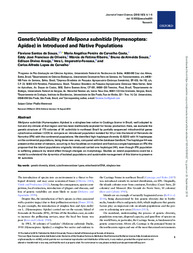Genetic variability of Melipona subnitida (Hymenoptera: Apidae) in introduced and native populations.
Genetic variability of Melipona subnitida (Hymenoptera: Apidae) in introduced and native populations.
Author(s): RIBEIRO, M. de F.; SOUZA, B. de A.
Summary: Melipona subnitida (Hymenoptera: Apidae) is a stingless bee native to Caatinga biome in Brazil, well adapted to hot and dry climate of that region and has been traditionally explored for honey production. Here, we evaluate the genetic structure of 173 colonies of M. subnitida in northeast Brazil by partially sequenced mitochondrial genes cytochrome oxidase I (COI) to compare an introduced population isolated for 30 yr into the Island of Fernando de Noronha (IFN) with the continental populations. We identified high haplotype diversity (0.8220) with 14 haplotypes on the continental populations, being three new ones, compared with the database GenBank. The haplotype H4 was present at the center of network, occurring in four localities on mainland and fixed as a single haplotype on IFN. We propose that the island populations originally introduced carried one haplotype (H4), even though IFN population is suffering pressure by island effect through changes on morphology. Studies on island populations could be a model to understand the dynamics of isolated populations and sustainable management of this biome to preserve M. subnitida.
Publication year: 2018
Types of publication: Journal article
Unit: Embrapa Semi-arid Region
Observation
Some of Embrapa's publications are published as ePub files. To read them, use or download one of the following free software options to your computer or mobile device. Android: Google Play Books; IOS: iBooks; Windows and Linux: Calibre.
Access other publications
Access the Agricultural Research Database (BDPA) to consult Embrapa's full library collection and records.
Visit Embrapa Bookstore to purchase books and other publications sold by Embrapa.

